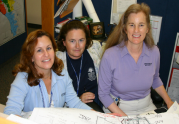
"The first step to success is stepping out of your comfort zone. At first I was a little timid or scared of speaking out and sharing ideas, but once I finally did, it built my confidence. I think a lot of women go through this, but you’ve got to make that first step, and the first step is the scariest.” |
|
Career Path: Geographic Information Systems (GIS) technicians use computer hardware, software, and geographic data to collect, manage, analyze, and display location information. New graduates will find employment as GIS technicians, working in governments or private industry. With more experience, a graduate might be promoted to work as a GIS analyst in the same industry. After achieving an advanced skill level or a four-year degree, graduates would qualify for more advanced analyst positions, management level opportunities or consulting roles.
Nature of the Work: The nature of the work as a GIS technician varies significantly depending on the industry, company, and job title. However, much of the work in GIS is spent at a computer. Work for interns and new graduates often may also involve collecting data about locations in the field, typing that data into computer databases, and perhaps mapping and overlaying that data with other related information such as roads or other landmarks.
For example, a GIS technician working in city government might collect information to pinpoint the location of water lines, customer locations, or fire hydrants and enter them into a city map, or collect plant species and put them into a database also using a Global Positioning System (GPS).
Work Environment: Although the majority of the work is seated at a computer in an office environment, field data collection in a wide variety of settings, often outdoors, may also be required, especially for entry-level positions. Experienced GIS technicians may work from home as a consultant allowing them to balance work and family responsibilities.
Specific Jobs Available to Graduates: This major can be applied in many settings dealing with spatial reasoning problems, and mapping and display of location information.
The following list indicates fields which may be open to graduates of SD Mesa’s GIS program:
- Geology, Geography & Oceanography
- Physical and Life Sciences
- Economics and Market Research Analysis
- City and Regional Planning
- Engineering and Transportation Management
- Property and Real Estate Management
- Communications and Utility Operations
- Surveying and Mapping Services
- Landscape Architecture
- Real Estate Broker Appraisal
- Police, Fire & Ambulance Dispatch
- Environmental Planning
- Natural Resource Management
Industries Employing Graduates of this Program: Because GIS is such a rapidly growing field, most local governments and many industries require trained workers. SD Mesa College partners with local industries on the San Diego Regional GIS Council, which meets quarterly, and provides oversight and advice to the GIS program staff. In the San Diego area, city governments including Escondido, Encinitas, Carlsbad, National City, La and San Diego hire GIS technicians, as well as the county and federal government, Navy and Marine Corps, and police and sheriff’s departments. Private consulting firms in environmental, transportation, water, and other planning services also employ graduates.
Course Description: The Geographic information Systems programs prepare students to use computer-based data management systems for gathering, storing, analyzing, and displaying spatial information. The program integrates the mapping sciences, geographic information systems technology, and spatial analysis with computer supported data storage, management and display functions. The course requires a work-study course in a public or private agency involving hands-on professional projects. San Diego College offers both a Certificate and an Associate in Science (A.S.) degree program in GIS.
The GIS Specialist Certificate program requires 13-16 units in the following courses:
- GISG 104 Geographic Information Science and Spatial Reasoning
- GISG 110 Introduction to Mapping and GIS
- GISG 111 Intermediate Applications
- GISG 112 Spatial Analysis
- GISG 113 Advanced GIS Applications
- GISG 270 GIS Work-Field Experience
The GIS Associate in Science (A.S.) degree program includes the following courses, four units in a programming language, and other general education requirements to total 60 units.
- GISG 110 Introduction to Mapping and GIS
- GISG 111 Intermediate Applications
- GISG 112 Spatial Analysis
- GISG 113 Advanced GIS Applications
- GISG 270 GIS Work-Field Experience
Prerequisites: Because this course requires a general understanding of geography and map reading, some students select GEOG 101, Physical Geography as one of their early electives. Students should also have basic computer and desktop software skills.
Hours Offered: Courses at SD Mesa College are offered during weekday and evening hours. Some general education courses are available online.
Length of Program: GIS Certificate: Most students complete the 13-16 unit certificate program in a year or less, depending on scheduling of the courses. GIS A.S. Degree: The A.S. degree is a full-time, two-year program which requires 60 units of coursework. This includes both general education requirements and courses required for the GIS major.
Financial Aid
I300 (1st floor)
7250 Mesa College Drive
San Diego, CA 92111
619.388.2817
http://www.sdmesa.edu/financial-aid/index.cfm
Tutoring Contact:
7250 Mesa College Drive, K210B
San Diego, CA 92111
619.388.2574
especht at sdccd.edu
http://www.sdmesa.edu/appointment-center/index.cfm
Academic Counseling:
http://www.sdmesa.edu/counseling/index.cfm
Job Placement:
http://www.sdmesa.edu/7student-services/career-center/career-center.html
A small amount of preparation can help make your days in the classroom go more smoothly. Visit the CalWomenTech Learning Library to find software and other tools to advance your math, spatial reasoning skills and much more. Learn about SD Mesa’s Tutoring Resources to find out how tutoring can help.
 Copyright 2010 National Institute for Women in Trades, Technology & Science | http://www.iwitts.com |


